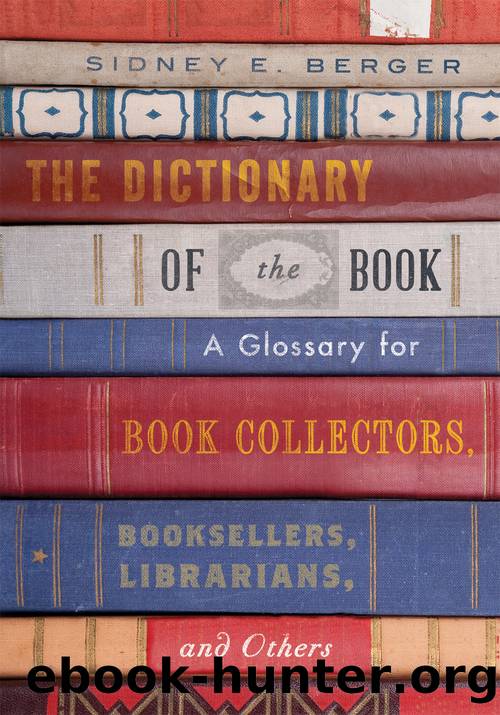The Dictionary of the Book by Sidney E. Berger

Author:Sidney E. Berger
Language: eng
Format: epub
ISBN: 9781442263406
Publisher: Rowman & Littlefield Publishers
Published: 2016-09-13T00:00:00+00:00
MOLD (papermaking) (Western; Asian). The device used for making paper. There are so many kinds of paper molds that coming up with a generic definition and description of them is futile. The best one can do is give a general description that illuminates what is usually meant by the term âpaper mold.â (I will use the Japanese terms since molds from Japan are more commonly written about in the West than are those from China or Korea, and Japanese terminology is much more known than are the words from other Asian countries.) In Asian papermaking, the mold consists of two parts: the su (the surface on which the fibers settle and the sheet is formed) and the geta (or ketaâthe frame that holds the su). Hence, the entire apparatus is called a sugeta (or suketa). The su is detachable; that is, a sheet is formed on the mold, and the su is removed so that the sheet can be couched (q.v.) onto a stack of like sheets.
Western paper molds consist of two parts: the mold and the deckle (q.v.). (Yes, the whole two-part apparatus is called a âmold,â and one of those two parts is also called the âmold.â) The deckle is the frame placed on top of the mold to hold the fibers on the surface of the mold after the vatman (q.v.) has dipped the mold into the vat to form a sheet.
Further, in mills where handmade paper is produced in large quantities, one common practice is to have a vatman (q.v.)âthe one forming the sheets at the vat (q.v.)âhave two molds and one deckle. He scoops up the pulp and forms a sheet on one mold, removes the deckle, hands the mold off to the coucher (see Couch), and receives from the coucher the second mold. (The deckle fits perfectly over both molds.) He is forming the next sheet while the coucher is couching the previous one. Hence, a âpaper moldâ consists of two molds and one deckle. (See Allan H. Stevenson. See also Watermark.)
Molds can be laid (q.v.) or wove (q.v.). That is, they can make laid paper or wove paper. (See Laid paper.) (See also Loeber, Paper Mould and Mouldmaker, and Stevenson, âWatermarks Are Twins.â)
Download
This site does not store any files on its server. We only index and link to content provided by other sites. Please contact the content providers to delete copyright contents if any and email us, we'll remove relevant links or contents immediately.
Asking the Right Questions: A Guide to Critical Thinking by M. Neil Browne & Stuart M. Keeley(5642)
Autoboyography by Christina Lauren(5184)
Eat That Frog! by Brian Tracy(4436)
Dialogue by Robert McKee(4323)
Sticky Fingers by Joe Hagan(4101)
Journeys Out of the Body by Robert Monroe(3572)
Annapurna by Maurice Herzog(3424)
Full Circle by Michael Palin(3389)
Schaum's Quick Guide to Writing Great Short Stories by Margaret Lucke(3319)
Elements of Style 2017 by Richard De A'Morelli(3307)
The Art of Dramatic Writing: Its Basis in the Creative Interpretation of Human Motives by Egri Lajos(3016)
Atlas Obscura by Joshua Foer(2899)
The Diviners by Libba Bray(2887)
In Patagonia by Bruce Chatwin(2876)
Why I Write by George Orwell(2874)
The Fight by Norman Mailer(2848)
The Mental Game of Writing: How to Overcome Obstacles, Stay Creative and Productive, and Free Your Mind for Success by James Scott Bell(2845)
Venice by Jan Morris(2526)
The Elements of Style by William Strunk and E. B. White(2442)
